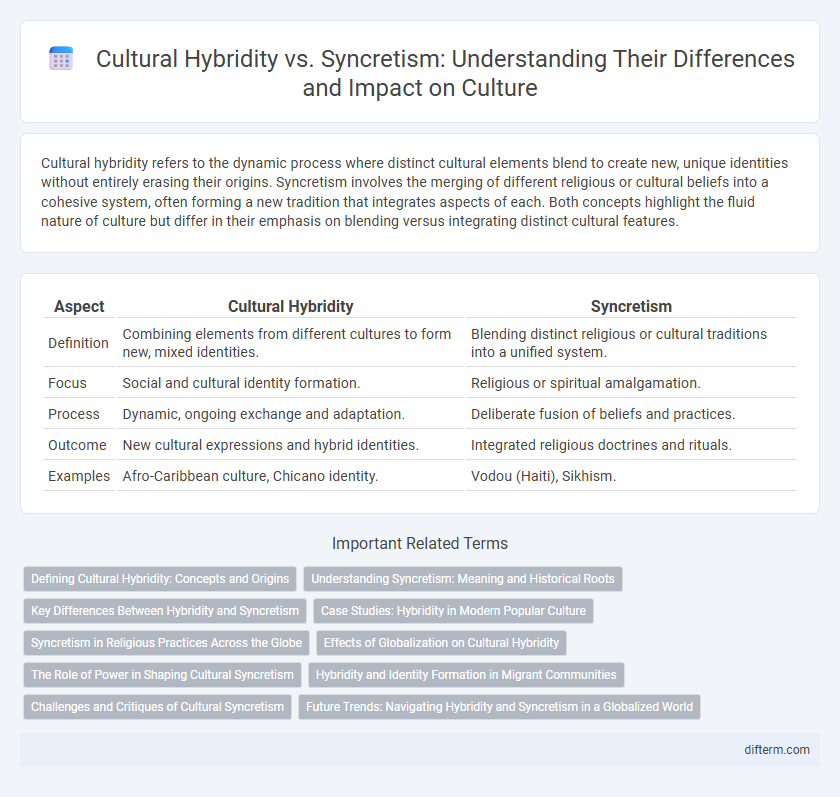Cultural hybridity refers to the dynamic process where distinct cultural elements blend to create new, unique identities without entirely erasing their origins. Syncretism involves the merging of different religious or cultural beliefs into a cohesive system, often forming a new tradition that integrates aspects of each. Both concepts highlight the fluid nature of culture but differ in their emphasis on blending versus integrating distinct cultural features.
Table of Comparison
| Aspect | Cultural Hybridity | Syncretism |
|---|---|---|
| Definition | Combining elements from different cultures to form new, mixed identities. | Blending distinct religious or cultural traditions into a unified system. |
| Focus | Social and cultural identity formation. | Religious or spiritual amalgamation. |
| Process | Dynamic, ongoing exchange and adaptation. | Deliberate fusion of beliefs and practices. |
| Outcome | New cultural expressions and hybrid identities. | Integrated religious doctrines and rituals. |
| Examples | Afro-Caribbean culture, Chicano identity. | Vodou (Haiti), Sikhism. |
Defining Cultural Hybridity: Concepts and Origins
Cultural hybridity refers to the dynamic process through which diverse cultural elements merge to create new, distinct identities and practices, often emerging in contexts of globalization and migration. Rooted in postcolonial theory, it challenges fixed cultural boundaries by emphasizing fluidity, interaction, and transformation between indigenous and foreign influences. This concept highlights the complexity of cultural exchange, differing from syncretism by focusing more on ongoing negotiation rather than fixed, synthesized systems.
Understanding Syncretism: Meaning and Historical Roots
Syncretism refers to the merging of distinct cultural, religious, or philosophical traditions into a cohesive system, often emerging from historical interactions such as colonization or trade. It involves the blending and adaptation of beliefs and practices, creating new, hybrid forms that retain elements from original sources but form novel identities. The historical roots of syncretism are evident in ancient civilizations like the Hellenistic period, where Greek, Egyptian, and Near Eastern cultures intermingled, as well as in the spread of religions like Buddhism and Christianity through cultural exchanges.
Key Differences Between Hybridity and Syncretism
Cultural hybridity involves the blending of distinct cultural elements to create new, dynamic identities, emphasizing fluidity and ongoing transformation. Syncretism refers to the merging of different religious or cultural traditions into a coherent system, often preserving recognizable components from each source. Key differences lie in hybridity's focus on interaction and innovation versus syncretism's emphasis on integration and synthesis of established practices.
Case Studies: Hybridity in Modern Popular Culture
Hybridity in modern popular culture emerges through the blending of distinct cultural elements, creating new, dynamic forms of expression evident in music genres like reggaeton and K-pop. Unlike syncretism, which merges religious or traditional practices into a cohesive whole, hybridity often emphasizes fluidity and ongoing negotiation of identity within globalized contexts. Case studies reveal how hybrid cultural products reflect power relations and the transnational flow of ideas, reshaping artistic and social landscapes across societies.
Syncretism in Religious Practices Across the Globe
Syncretism in religious practices involves the blending of different belief systems and rituals, resulting in hybrid faith expressions that transcend original doctrines. This phenomenon is evident in regions like Latin America, where indigenous traditions merge with Christianity, creating unique worship forms such as Santeria and Candomble. Syncretism fosters cultural continuity and communal identity by integrating diverse religious elements into cohesive, evolving spiritual practices.
Effects of Globalization on Cultural Hybridity
Globalization accelerates cultural hybridity by facilitating constant cross-cultural interactions, leading to the blending of traditions, languages, and social norms across borders. This dynamic process fosters innovation and diversity in cultural expressions while challenging traditional cultural boundaries. As a result, cultural hybridity becomes a living, evolving phenomenon shaped by global flows of people, media, and technology.
The Role of Power in Shaping Cultural Syncretism
Power dynamics critically influence cultural syncretism by determining which cultural elements merge, dominate, or are suppressed in hybrid formations. Colonialism and imperialism often orchestrate syncretic processes through asymmetric power relations, embedding dominant cultural symbols within marginalized traditions to establish control and legitimacy. This unequal power structure shapes syncretism as a strategic adaptation rather than a purely mutual exchange, reflecting hegemonic influence in the evolution of blended cultural identities.
Hybridity and Identity Formation in Migrant Communities
Cultural hybridity in migrant communities plays a crucial role in identity formation by blending elements from both origin and host cultures, creating unique social practices and self-conceptions. This process fosters dynamic identities that resist fixed cultural boundaries, enabling migrants to navigate complex social landscapes while preserving aspects of their heritage. Hybridity promotes cultural innovation and adaptability, contributing to more inclusive and multifaceted community identities.
Challenges and Critiques of Cultural Syncretism
Cultural syncretism faces challenges such as the loss of original cultural identities and the oversimplification of complex traditions, leading to potential misunderstandings. Critics argue that syncretism can mask power imbalances by blending dominant and marginalized cultures in ways that favor one side. These critiques highlight the tension between preserving authentic cultural expressions and the dynamic, often uneven process of cultural fusion.
Future Trends: Navigating Hybridity and Syncretism in a Globalized World
Cultural hybridity and syncretism will increasingly shape global cultural landscapes as digital connectivity accelerates intercultural exchange and adaptation. Emerging trends emphasize dynamic fusion processes where hybrid identities evolve through selective blending rather than mere coexistence, fostering innovative expressions in art, language, and social practices. The future highlights the importance of navigating hybridity and syncretism consciously to balance cultural preservation with transformative creativity in an interconnected world.
cultural hybridity vs syncretism Infographic

 difterm.com
difterm.com